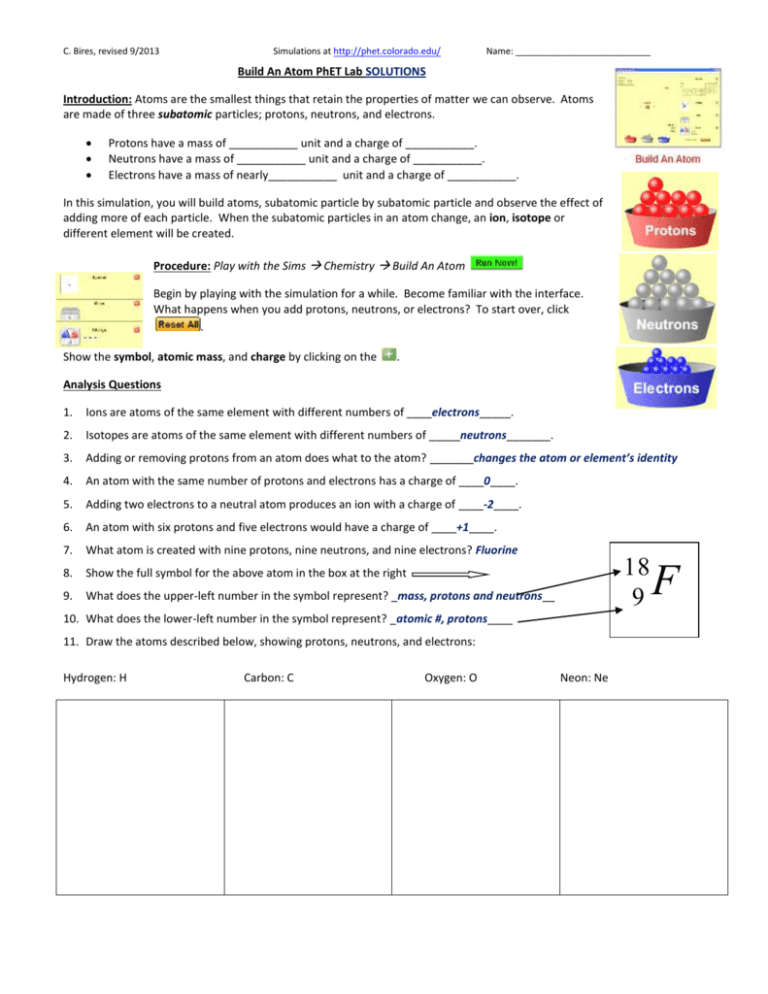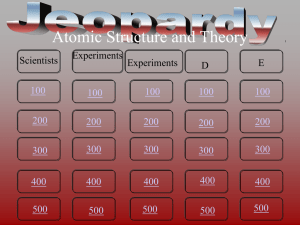Build an Atom PhET
advertisement

C. Bires, revised 9/2013 Simulations at http://phet.colorado.edu/ Name: ___________________________ Build An Atom PhET Lab SOLUTIONS Introduction: Atoms are the smallest things that retain the properties of matter we can observe. Atoms are made of three subatomic particles; protons, neutrons, and electrons. Protons have a mass of ___________ unit and a charge of ___________. Neutrons have a mass of ___________ unit and a charge of ___________. Electrons have a mass of nearly___________ unit and a charge of ___________. In this simulation, you will build atoms, subatomic particle by subatomic particle and observe the effect of adding more of each particle. When the subatomic particles in an atom change, an ion, isotope or different element will be created. Procedure: Play with the Sims Chemistry Build An Atom Begin by playing with the simulation for a while. Become familiar with the interface. What happens when you add protons, neutrons, or electrons? To start over, click . Show the symbol, atomic mass, and charge by clicking on the . Analysis Questions 1. Ions are atoms of the same element with different numbers of ____electrons_____. 2. Isotopes are atoms of the same element with different numbers of _____neutrons_______. 3. Adding or removing protons from an atom does what to the atom? _______changes the atom or element’s identity 4. An atom with the same number of protons and electrons has a charge of ____0____. 5. Adding two electrons to a neutral atom produces an ion with a charge of ____-2____. 6. An atom with six protons and five electrons would have a charge of ____+1____. 7. What atom is created with nine protons, nine neutrons, and nine electrons? Fluorine 8. Show the full symbol for the above atom in the box at the right 9. What does the upper-left number in the symbol represent? _mass, protons and neutrons__ 18 9 10. What does the lower-left number in the symbol represent? _atomic #, protons____ 11. Draw the atoms described below, showing protons, neutrons, and electrons: Hydrogen: H Carbon: C Oxygen: O Neon: Ne F C. Bires, revised 9/2013 Simulations at http://phet.colorado.edu/ Name: ___________________________ The Game With remaining class time, play a few games. Who in your lab group can get the highest score? WINNER: _______________ Complete the table below Remember…when there are more electrons than protons, the charge should be: _____negative____. And when there are more protons than electrons, the charge will be: ______positive_________. Protons Neutrons Electrons 4 4 4 5 5 6 Atomic Number Mass Number Charge Element 4 8 0 Be 8 4 10 -1 B 16 +1 O 13 -3 N 20 -1 F 4. 10 5 9. 16 8 14. 13 7 19. 20 9 5 8 1. 8 8 7 6. 11. 16. 7 9 6 10 11 10 12. 17. 7 13. 9 18. 2. 7. 3. 8. Full Symbol Be B O N F Conclusion Questions (use a periodic table) 1. All Zinc atoms have (how many?) __30__ protons. 2. If a Copper atom has no charge (neutral), it would contain (how many?) ___29__ electrons. 3. All atoms that have 14 protons are (what element?) _silicon____. 4. If an atom of Zinc has a mass of 64, it has (how many?) ___34___ neutrons. 5. Silver-108 has a mass of 108. This means that it would have (how many?) __61__ neutrons with its 47 protons. 6. 23 11 Na (Sodium) has (how many?) ___11__ protons and (how many?) ___12__ neutrons for a total mass of 23. 7. A -1 ion of Bromine would have ___35__ protons and ___36__ electrons. 8. A +2 ion of Calcium would have ___20__ protons and ___18__ electrons. 9. To form an ion with a -2 charge, an atom of Sulfur would need to have __18___ electrons. 10. A neutral atom of Zinc-66 has __30___ protons, __36___ neutrons, and __30___ electrons.







